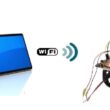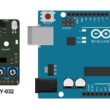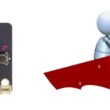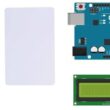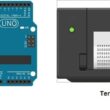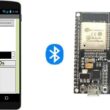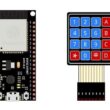The ESP32 card
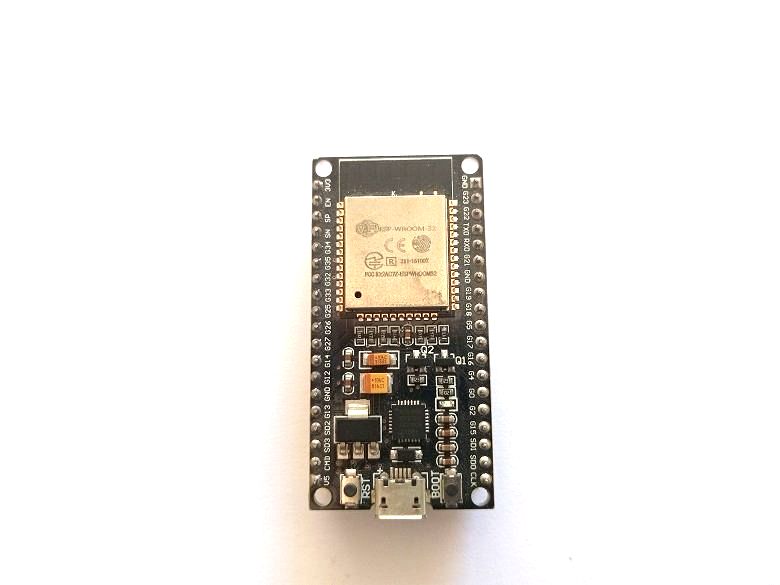
What is an ESP32 card ?
The ESP32 is a powerful, versatile development board that is often used in a wide variety of electronic projects. It is built around the ESP32 microcontroller, which is a powerful, dual-core processor with built-in Wi-Fi and Bluetooth connectivity. The ESP32 board features a wide variety of input/output (I/O) pins, allowing users to interface with a wide range of sensors, actuators, and other electronic components. It also features a variety of on-board peripherals, including a touch sensor, an LED, and a micro-USB port for programming and power.
The ESP32 is particularly well-suited for projects related to the Internet of Things (IoT), as it provides easy and reliable wireless connectivity through its built-in Wi-Fi and Bluetooth capabilities. It can be programmed using a variety of languages, including Arduino IDE, MicroPython, and the ESP-IDF framework. Its powerful dual-core processor and on-board memory make it capable of handling complex data processing tasks, such as real-time data analysis and machine learning algorithms.
The ESP32 is also frequently used in robotics projects, where it can provide a reliable and powerful control platform for motor control, sensor input, and data processing. It is highly programmable and adaptable, making it suitable for a wide range of robotics applications, from hobbyist projects to industrial automation.
ESP32 board pins
The ESP32 board features a variety of input/output (I/O) pins, which can be used to interface with a wide range of sensors, actuators, and other electronic components. Here is a summary of the different types of pins found on an ESP32 board:
Digital I/O pins: The ESP32 has a total of 38 digital I/O pins, which can be used for both input and output. These pins can be set to high or low using digitalWrite() function in Arduino IDE, and can be read using digitalRead() function.
Analog Input pins: The ESP32 has 18 analog input pins, which can be used to read analog voltages from sensors. These pins can be read using analogRead() function in Arduino IDE.
PWM pins: The ESP32 has 16 PWM (Pulse Width Modulation) pins, which can be used to control the brightness of LEDs or the speed of motors.
I2C pins: The ESP32 has two I2C (Inter-Integrated Circuit) pins, which can be used to interface with I2C devices such as sensors or displays.
SPI pins: The ESP32 has four SPI (Serial Peripheral Interface) pins, which can be used to interface with SPI devices such as flash memory or sensors.
UART pins: The ESP32 has three UART (Universal Asynchronous Receiver-Transmitter) pins, which can be used to communicate with other serial devices such as GPS modules or Bluetooth modules.
DAC pins: The ESP32 has two DAC (Digital to Analog Converter) pins, which can be used to output analog voltages.
ADC pins: The ESP32 has a total of 18 ADC (Analog to Digital Converter) pins, which can be used to read analog voltages from sensors.
How to program the ESP32 board ?
There are several ways to program the ESP32 board, depending on the programming language and tools you prefer to use. Here are some of the most common ways to program the ESP32:
Arduino IDE: The Arduino Integrated Development Environment (IDE) is a popular way to program the ESP32 board. You can install the ESP32 board support in the Arduino IDE by following the instructions provided by the manufacturer. Once you have set up the board in the Arduino IDE, you can use the familiar Arduino functions and syntax to write your code and upload it to the ESP32 board via a USB cable.
MicroPython: MicroPython is a lightweight implementation of the Python 3 programming language optimized for microcontrollers such as the ESP32. To program the ESP32 with MicroPython, you need to first install MicroPython firmware onto the board. Then you can use any text editor to write your MicroPython code and upload it to the ESP32 board via a USB cable.
ESP-IDF: The Espressif IoT Development Framework (ESP-IDF) is the official software development kit (SDK) for the ESP32. It provides a set of libraries and tools for developing applications on the ESP32 platform. To use ESP-IDF, you need to install it on your computer and then use a command-line interface to write and compile your code. You can then upload the compiled binary file to the ESP32 board via a USB cable or over-the-air (OTA) using Wi-Fi.
PlatformIO: PlatformIO is an open source ecosystem for IoT development that supports multiple platforms, including the ESP32. It provides a cross-platform IDE and a unified interface for building and uploading code to the ESP32. PlatformIO also supports a wide range of programming languages and frameworks, including Arduino, ESP-IDF, and MicroPython.
The difference between ESP32 board and Arduino board
The ESP32 board and Arduino board are both popular microcontroller development boards used for a wide range of electronic projects. While they share some similarities, there are also several key differences between them. Here are some of the main differences:
Processor: The ESP32 board is powered by a dual-core 32-bit CPU, while most Arduino boards use an 8-bit or 32-bit microcontroller. This means that the ESP32 can handle more complex tasks and is better suited for applications that require more processing power.
Connectivity: The ESP32 board comes with built-in Wi-Fi and Bluetooth connectivity, which makes it easy to connect to the internet and other devices wirelessly. Arduino boards typically do not have built-in connectivity and require additional shields or modules to connect to the internet or other devices wirelessly.
Cost: The ESP32 board is generally more expensive than most Arduino boards, due to its higher processing power and built-in connectivity. However, there are also lower-cost versions of the ESP32 board available, which may be more affordable for some projects.
Programming language: The ESP32 board can be programmed using a variety of programming languages, including C, C++, Python, and MicroPython. Arduino boards are typically programmed using the Arduino programming language, which is based on C++.
I/O pins: The ESP32 board has a greater number of I/O pins than most Arduino boards, which makes it more versatile and better suited for complex projects that require multiple sensors and actuators.
In summary, the ESP32 board is generally more powerful and versatile than most Arduino boards, thanks to its dual-core CPU and built-in connectivity. However, Arduino boards are still a popular choice for simpler projects and for those who prefer the ease of use and community support provided by the Arduino ecosystem.[/vc_column_text]
Why is the ESP32 board suitable for Internet of Things (IoT) related projects ?
The ESP32 board is well-suited for Internet of Things (IoT) related projects for several reasons:
Built-in connectivity: The ESP32 board comes with built-in Wi-Fi and Bluetooth connectivity, which makes it easy to connect to the internet and other devices wirelessly. This is essential for IoT projects, which often involve connecting multiple devices and collecting data from sensors.
Low power consumption: The ESP32 board has a low power consumption mode, which makes it ideal for battery-powered IoT devices that need to conserve power.
Processing power: The ESP32 board is powered by a dual-core 32-bit CPU, which makes it capable of handling complex tasks and processing large amounts of data. This is important for IoT projects that require data processing and analysis.
Versatility: The ESP32 board has a wide range of I/O pins and supports multiple communication protocols, including SPI, I2C, and UART. This makes it versatile and suitable for a wide range of IoT projects.
Open-source community: The ESP32 board has a large and active open-source community, which provides a wealth of resources, tutorials, and libraries that can be used to develop IoT projects. This community also provides ongoing support and development for the ESP32 board, which ensures that it remains a relevant and powerful platform for IoT development.
In summary, the ESP32 board is a versatile and powerful platform that is well-suited for IoT-related projects. Its built-in connectivity, low power consumption, processing power, and versatility make it an attractive option for developers who want to build innovative and connected IoT device
Role of ESP32 board in robotics projects
The ESP32 board can play a significant role in robotics projects as it offers a powerful and versatile platform for controlling and communicating with various components of a robot. Here are some specific ways the ESP32 board can be used in robotics projects:
Motor control: The ESP32 board has several PWM pins, which can be used to control the speed and direction of motors. This makes it a good choice for controlling the movement of robots.
Sensor integration: The ESP32 board has a wide range of I/O pins and supports multiple communication protocols, which makes it easy to integrate various sensors such as ultrasonic sensors, IR sensors, and accelerometers. This allows the robot to detect and respond to its environment.
Wireless communication: The ESP32 board has built-in Wi-Fi and Bluetooth connectivity, which makes it easy to establish wireless communication between the robot and other devices. This can be used to control the robot remotely, or to send data from the robot to a cloud-based server for analysis.
Power management: The ESP32 board has a low power consumption mode, which is important for battery-powered robots that need to conserve power. Additionally, the ESP32 board can be programmed to control power to various components of the robot, which can help to extend the battery life.
Control system: The ESP32 board can be used as the central control system for the robot, allowing it to execute commands and respond to inputs from sensors. This can be programmed using a variety of programming languages, including C, C++, Python, and MicroPython.















